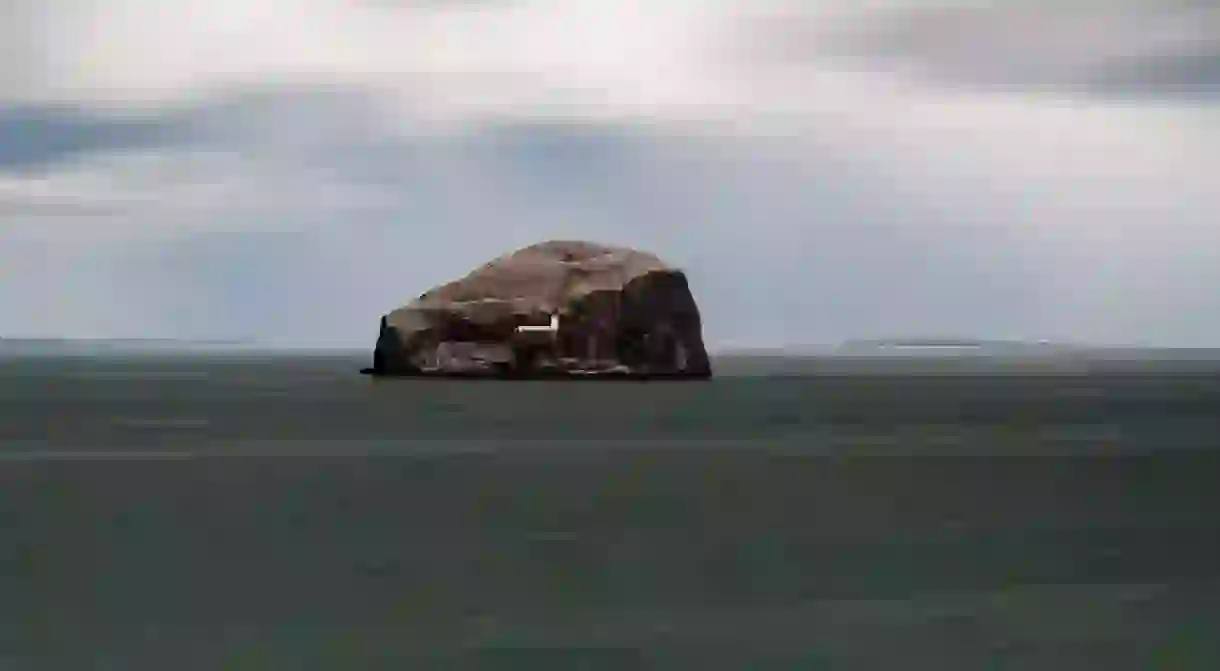A Brief History Of The Bass Rock

Upon first glimpse, the Bass Rock, an island just off North Berwick in East Lothian, Scotland, resembles a white iceberg floating in the Firth of Forth. Look a little closer to see that this intriguing white lump of carboniferous rock is actually smothered in a myriad of bird droppings.
Described by Sir David Attenborough as ‘one of the 12 wildlife wonders of the world’, the Bass Rock is a sanctuary for gannets, hosting over 150,000 of them during peak breeding season. Not only is it the closest bird sanctuary to the mainland, but it also saw the first ornithologists, who gave the gannet the scientific term Sula Bassana or Morus Bassanus. Notably, they gave this glistening rock, which boasts the largest ‘single rock’ colony of northern gannets on the planet, a shout-out when crafting a name.

Sporting treacherous jagged edges, precariously placed cliffs, ancient chapel ruins, a lighthouse, and a castle-turned-prison, this volcanic plug is a Site Of Special Scientific Interest. The father of modern geology himself, James Hutton, was the first to recognise it as an igneous intrusion, which happens when magmna is trapped beneath the earth’s surface and pushes tge rock above it out into a dome shap. In 1847, Hugh Miller visited the Bass and further wrote about the geology in his book.
Unsurprisingly, The Bass appears in Catriona, the sequel to Kidnapped by the prolific Scottish writer Robert Louis Stevenson, who described it as ‘just the one crag of rock, as everybody knows, but great enough to carve a city from.’ Coincidentally, his cousin, David Stevenson, designed the Bass lighthouse, which appeared in 1902.
It is said that the very first of all human inhabitants was Saint Baldred in 600 AD, an evangelist, monastery founder, and hermit. Today, only the ruins of Saint Baldred’s Chapel remain upon the spot he used to frequent. The chapel was bestowed upon the Lauder family by the church in 1316.

Currently uninhabited by humans, the Bass Rock was passed on to the family of Sir Hew Hamilton-Dalyrmple in 1706, after being in the Lauder family for nearly six centuries. Legend states that the island was a present from King Malcolm III of Scotland. Over the years, the Lauders received a string of royal visitors such as King James IV in 1497 and King James VI of Scotland in 1581.
In 1671, the Bass Rock was commandeered from the Lauder family and transformed into Scotland’s own Alcatraz following the Commonwealth period and Cromwell’s invasion of Scotland. Subsequently, this castle-turned-prison became riddled with religious and political prisoners such as Walter Stewart and members of Clan MacKay. Significantly, it was also filled with large numbers of Covenanters, including Prophet Peden. From 1672 to 1688, approximately 40 people died in the depths of the dungeons. Additionally, 1688–1692 saw a handful of prisoners contained during the first Jacobite Rising.
If you are inspired to visit this natural wonder, then the Scottish Seabird Centre hold exclusive landing trips from Easter to Autumn, weather dependant, ferrying tourists in local fishing boats and accompanied by an expert guide. With an average time of 3 hours on the island to explore, this is a fascinating destination for photographers, hungry historians and wildlife enthusiasts. It is little wonder that Bass Rock was named BBC Countryfile Magazine’s Nature Reserve of the Year.














